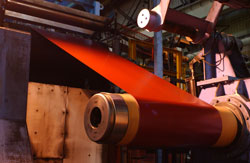
Posted to News on 2nd Oct 2009, 16:34
Drives cut energy consumption on hydraulic system
Installing an ABB industrial drive has resulted in a 70 per cent energy saving on a hydraulic system for steel manufacturer Corus Colors, resulting in a payback period of 18 months.

Corus Colors has a hydraulic system on a production line used for retreating and inspecting strip material, driving actuators and web guiding systems in a 24-hour process. Hydraulic systems often waste much of their energy because a fluid circulates at all times, although the work is only carried out in short bursts. In addition, the pressure for the hydraulic system is normally provided with a positive displacement pump, which offers far less potential to save energy than centrifugal pumps.
Nevertheless, Corus Colors, with the help of Phil Tomkinson from Radway Control Systems, achieved significant energy savings by retrofitting the existing system with a variable-speed drive (VSD). The pump speed was greatly reduced both when the system was in neutral and during actuation of the cylinders.
When in neutral, power consumption was initially around 9kW; under drive control, power consumption was reduced to 2kW, which represents a reduction of 77 per cent. With the system under load, power consumption was reduced from 22kW to 12kW, a saving of 48 per cent.
Rapid payback
With a 16 per cent duty on-load time for the system, the average energy saving over time was 70 per cent. The reduced energy consumption will allow a payback time of just 18 months and reduce the company's carbon footprint by 33 tonnes of CO2 annually.
The reduction in energy consumption under load initially surprised Corus' engineers, as it might be thought that the same amount of energy is required to move a hydraulic cylinder a given distance, regardless of whether a drive or direct-on-line operation is used. However, further tests showed that the drive used a lower motor speed to achieve the required pressure.
Furthermore, the drive automatically adjusts the pump speed to maintain system pressure, with a pressure transducer providing a feedback signal to the drive. The drive supplied by ABB Drives Distributor Radway Control Systems has built-in PID control that helps keep external values, like pressure, under control.
The desired system pressure is 90bar. As in most hydraulic systems, the on-load times are short. To prevent energy being wasted once the hydraulic system settles back into neutral, the drive operates in two modes: PID mode and single-speed mode. When the hydraulic system is in neutral and the pressure is at the desired level, the drive switches to a single speed of 450rpm, which tests identified as the optimum constant speed setting. This way, the system will not overshoot its target pressure.
Control loop
When the actuator is operated and the pressure drops, the transducer feedback switches the drive into PID operation. The drive reacts quickly to speed up the motor as fast as possible to reach its preset value, set at 93bar. But as soon as the pressure reaches 90bar, the transducer switches the drive back into single-speed mode, preventing the motor from overshooting its target speed and reducing energy wasage. The hysteresis control built into the drive stops it switching in and out too quickly. The drive's flux optimisation feature reduces the magnetising current when the motor runs at constant speed and gives further energy savings.
In the past, drives were not used much on hydraulic systems, maybe because the very impressive energy savings available with centrifugal pumps are not achievable with positive displacement pumps.
Unlike a centrifugal pump, which uses centrifugal force, the positive displacement pump uses an internal mechanism to press the fluid out. This means the output will be the same regardless of the resistance on the discharge side. Positive displacement pumps tend to be used in hydraulic systems because this type of pump can produce high pressure despite high system resistance.
However, the energy consumption of the positive displacement pump is not reduced when the system resistance drops. For this reason, it does not offer the same energy saving potential as centrifugal pumps at reduced speed. While the centrifugal pump offers energy savings equal to the cube of the speed reduction, a change in flow by the positive displacement pump produces a linear change in power usage.
ABB Automation Technologies (Drives and Motors)
3100 Daresbury Park
Daresbury
WA4 4BY
UNITED KINGDOM
44 1925 741 111






























